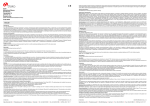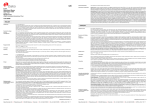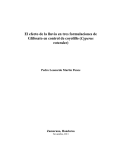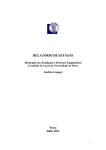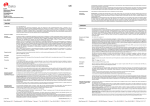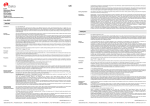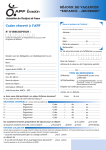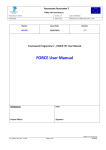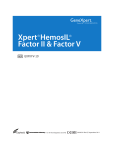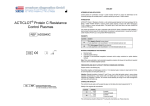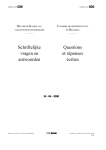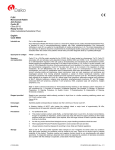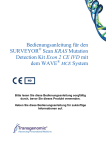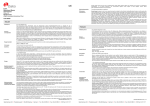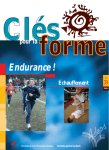Download FLEX Monoclonal Mouse Anti-Human p53 Protein Clone DO
Transcript
Counterstaining in hematoxylin is recommended using EnVision FLEX Hematoxylin, (Dako Autostainer/Autostainer Plus) (Code K8018). Non-aqueous, permanent mounting medium is recommended. Positive and negative controls should be run simultaneously using the same protocol as the patient specimens. The positive control tissue should include colon and colon adenocarcinoma and the cells/structures should display reaction patterns as described for these tissues in “Performance characteristics” in all positive specimens. The recommended negative control reagent is FLEX Negative Control, Mouse, (Dako Autostainer/Autostainer Plus) (Code IS750). FLEX Monoclonal Mouse Anti-Human p53 Protein Clone DO-7 Ready-to-Use (Dako Autostainer/Autostainer Plus) Staining interpretation Cells labeled by the antibody generally display nuclear staining, but cytoplasmic staining has been reported in some cases (6). Performance characteristics Normal tissues: In normal and reactive mesothelium the antibody labels 0/40 cases, and in 27 mesotheliomas, normal cells, e.g. fibroblasts and endothelial cells are negative (3). In colon, only the scattered benign basal epithelial cells show a weak to moderate nuclear staining reaction. Abnormal tissues: In follicular lymphoma an increasing accumulation of p53 in centroblasts was observed with morphological progression resulting in 1/16 cases of grade l, 10/21 cases of grade ll, and 6/6 cases of grade lll being positive (4). In mesotheliomas the antibody labeled 7/26 cases of epithelial type (1 to 25% positive cells), 1/7 cases of mixed type (25 to 50% positive cells), and 1/3 cases of mesenchymal type (more than 75% positive cells) (3). In Hodgkin’s lymphoma 65% or more showed positive labeling for p53, whereas around 50% of non-Hodgkin’s lymphomas were positive (2). The neoplastic cells in colon adenocarcinoma show a moderate to strong nuclear staining reaction. Code IS616 FRANÇAIS ENGLISH Intended use For in vitro diagnostic use. FLEX Monoclonal Mouse Anti-Human p53 Protein, Ready-to-Use, (Dako Autostainer/Autostainer Plus), is intended for use in immunohistochemistry together with Dako Autostainer/Autostainer Plus instruments. This antibody labels wild-type and mutant-type p53 protein and is useful for the identification of p53 accumulation in human neoplasias (1-3). The clinical interpretation of any staining or its absence should be complemented by morphological studies using proper controls and should be evaluated within the context of the patient's clinical history and other diagnostic tests by a qualified pathologist. Summary and explanation p53 is a nuclear phosphoprotein with a molecular mass of 53 kDa. Wild-type p53 protein is present in a wide variety of normal cells, but the protein has a very short half-life and thus is present in only minute amounts (1), generally below the detection level of immunohistochemical methods (4). Somatic mutation of the p53 gene is a very frequent event in the development of human neoplasia, and because mutant p53 proteins often are much more stable than wild-type p53 protein, the mutant p53 protein accumulates to a high level (1). As examples, p53 protein accumulation was observed in 76% of 212 human malignant lesions, including breast, colon and stomach carcinomas, melanoma, embryonal carcinoma of the testis, transitional carcinoma of the urinary bladder, uterine carcinoma and soft tissue sarcomas (5). Wild-type p53 protein functions as a transcription factor, i.e. as a modulator, which can turn crucial genes either on or off. It also inhibits DNA replication and is a checkpoint control molecule for progression of the cell cycle. Furthermore, p53 protein is involved in the regulation of apoptosis (2). In transfection assays, wild-type p53 behaves as a tumor suppressor, while mutant p53 behaves as a dominant transforming oncogene (1). Refer to Dako’s General Instructions for Immunohistochemical Staining or the detection system instructions of IHC procedures for: 1) Principle of Procedure, 2) Materials Required, Not Supplied, 3) Storage, 4) Specimen Preparation, 5) Staining Procedure, 6) Quality Control, 7) Troubleshooting, 8) Interpretation of Staining, 9) General Limitations. Reagent provided Ready-to-use monoclonal mouse antibody provided in liquid form in a buffer containing stabilizing protein and 0.015 mol/L sodium azide. Clone: DO-7 (1). Isotype: IgG2b, kappa. Immunogen Recombinant human wild-type p53 protein (1). Specificity In Western blotting of lysate of the A431 human vulval carcinoma cell line, the antibody labels a 53 kDa band, corresponding to the mutant type p53, which is expressed by A431. The epitope recognized by the antibody is located between the N-terminal amino acids 1 and 45 and possibly between amino acids 37 and 45 of the human p53 protein (1). SDS-PAGE analysis of immunoprecipitates formed between lysate of the BT474 breast cancer cell line and the antibody shows reaction with a 53 kDa protein corresponding to p53 (1). In immunohistochemistry the antibody labels mutant-type p53 in the A431 cell line and wild-type p53 in the SVK14 cell line (SV40-transformed keratinocyte line) (1). 1. For professional users. 2. This product contains sodium azide (NaN3), a chemical highly toxic in pure form. At product concentrations, though not classified as hazardous, sodium azide may react with lead and copper plumbing to form highly explosive build-ups of metal azides. Upon disposal, flush with large volumes of water to prevent metal azide build-up in plumbing. 3. As with any product derived from biological sources, proper handling procedures should be used. 4. Wear appropriate Personal Protective Equipment to avoid contact with eyes and skin. 5. Unused solution should be disposed of according to local, State and Federal regulations. Precautions Store at 2-8 °C. Do not use after expiration date sta mped on vial. If reagents are stored under any conditions other than those specified, the conditions must be verified by the user. There are no obvious signs to indicate instability of this product. Therefore, positive and negative controls should be run simultaneously with patient specimens. If unexpected staining is observed which cannot be explained by variations in laboratory procedures and a problem with the antibody is suspected, contact Dako Technical Support. Storage Specimen preparation including materials required but not supplied The antibody can be used for labeling formalin-fixed, paraffin-embedded tissue sections. Tissue specimens should be cut into sections of approximately 4 µm. Pre-treatment with heat-induced epitope retrieval (HIER) is required using Dako PT Link (Code PT100/PT101). For details, please refer to the PT Link User Guide. Optimal results are obtained by pretreating tissues using EnVision FLEX Target Retrieval Solution, High pH (50x) (Code K8010/K8004). Paraffin-embedded sections: Pre-treatment of formalin-fixed, paraffin-embedded tissue sections is recommended using the 3-in-1 specimen preparation procedure for Dako PT Link. Follow the pre-treatment procedure outlined in the package insert for EnVision FLEX Target Retrieval Solution, High pH (50x) (Code K8010/K8004). Note: After staining the sections must be dehydrated, cleared and mounted using permanent mounting medium. Deparaffinized sections: Pre-treatment of deparaffinized formalin-fixed, paraffin-embedded tissue sections is recommended using Dako PT Link and following the same procedure as described for paraffin-embedded sections. After staining the slides should be mounted using aqueous or permanent mounting medium. The tissue sections should not dry out during the treatment or during the following immunohistochemical staining procedure. For greater adherence of tissue sections to glass slides, the use of FLEX IHC Microscope Slides (Code K8020) is recommended. Staining procedure including materials required but not supplied The recommended visualization system is EnVision FLEX, High pH, (Dako Autostainer/Autostainer Plus) (Code K8010). The staining steps and incubation times are pre-programmed into the software of Dako Autostainer/Autostainer Plus instruments, using the following protocols: Template protocol: FLEXRTU2 (200 µL dispense volume) or FLEXRTU3 (300 µL dispense volume) Autoprogram: p53 (without counterstaining) or p53H (with counterstaining) The Auxiliary step should be set to “rinse buffer” in staining runs with ≤10 slides. For staining runs with >10 slides the Auxiliary step should be set to “none”. This ascertains comparable wash times. All incubation steps should be performed at room temperature. For details, please refer to the Operator’s Manual for the dedicated instrument. If the protocols are not available on the used Dako Autostainer instrument, please contact Dako Technical Services. Optimal conditions may vary depending on specimen and preparation methods, and should be determined by each individual laboratory. If the evaluating pathologist should desire a different staining intensity, a Dako Application Specialist/Technical Service Specialist can be contacted for information on reprogramming of the protocol. Verify that the performance of the adjusted protocol is still valid by evaluating that the staining pattern is identical to the staining pattern described in “Performance characteristics”. (115259-003) Dako Denmark A/S IS616/EFG/MNI/2009.12.04 p. 1/4 | Produktionsvej 42 | DK-2600 Glostrup | Denmark | Tel. +45 44 85 95 00 | Fax +45 44 85 95 95 | CVR No. 33 21 13 17 Utilisation prévue Pour utilisation diagnostique in vitro. FLEX Monoclonal Mouse Anti-Human p53 Protein, Ready-to-Use, (Dako Autostainer/Autostainer Plus) est destiné à une utilisation en immunohistochimie avec les instruments Dako Autostainer/Autostainer Plus. Cet anticorps marque la protéine p53 de types sauvage et mutant et facilite l’identification de l’accumulation de p53 dans les néoplasies humaines (1-3). L’interprétation clinique de toute coloration ou son absence doit être complétée par des études morphologiques en utilisant des contrôles appropriés et doit être évaluée en fonction des antécédents cliniques du patient et d’autres tests diagnostiques par un pathologiste qualifié. Résumé et explication La p53 est une phosphoprotéine nucléaire ayant une masse moléculaire de 53 kDa. La protéine p53 de type sauvage est présente dans un grand nombre de cellules normales mais cette protéine a une demi-vie très courte et n’est donc présente qu’en faible teneur (1), généralement en deçà du seuil de détection des méthodes immunohistochimiques (4). La mutation somatique du gène p53 est un événement très fréquent dans le développement des néoplasies humaines et, du fait que les protéines p53 mutantes sont souvent beaucoup plus stables que la protéine p53 de type sauvage, la protéine p53 mutante s’accumule à un taux élevé (1). Par exemple, une accumulation de protéine p53 a été observée dans 76 % des 212 lésions malignes humaines, notamment les carcinomes du sein, du côlon et de l’estomac, le mélanome, le carcinome embryonnaire du testicule, le carcinome transitionnel de la vessie, le carcinome utérin et les sarcomes des tissus mous (5). La protéine p53 de type sauvage agit comme facteur de transcription, c’est-à-dire comme modulateur qui peut soit activer, soit désactiver des gènes cruciaux. Elle inhibe également la réplication de l’ADN et est une molécule de contrôle des différentes étapes de la progression du cycle cellulaire. De plus, la protéine p53 est impliquée dans la régulation de l’apoptose (2). Dans les essais de transfection, la p53 de type sauvage se comporte comme suppresseur de tumeur, alors que la p53 mutante agit comme oncogène transformant dominant (1). Se référer aux Instructions générales de coloration immunohistochimique de Dako ou aux instructions du système de détection relatives aux procédures IHC pour plus d’informations concernant les points suivants : 1) Principe de procédure, 2) Matériels requis mais non fournis, 3) Conservation, 4) Préparation des échantillons, 5) Procédure de coloration, 6) Contrôle qualité, 7) Dépannage, 8) Interprétation de la coloration, 9) Limites générales. Réactifs fournis Anticorps monoclonal de souris prêt à l’emploi fourni sous forme liquide dans un tampon contenant une protéine stabilisante et 0,015 mol/L d’azide de sodium. Clone : DO-7 (1). Isotype : IgG2b, kappa. Immunogène Protéine p53 recombinante humaine de type sauvage (1). Spécificité Dans les analyses par Western blot du lysat de lignée cellulaire de carcinome vulvaire humain A431, l’anticorps marque une bande de 53 kDa, correspondant à la p53 de type mutant, qui est exprimée par l’A431. L’épitope reconnu par l’anticorps est localisé entre les acides aminés 1 et 45 du Nterminal et éventuellement entre les acides aminés 37 et 45 de la protéine p53 humaine (1). L’immunoblot PAGE en présence de SDS d’immunoprécipités formés entre le lysat de lignée cellulaire de cancer du sein BT474 et l’anticorps présente une réaction à une protéine de 53 kDa correspondant à la p53 (1). En immunohistochimie, l’anticorps marque la p53 de type mutant dans la lignée cellulaire A431 et la p53 de type sauvage dans la lignée cellulaire SVK14 (lignée de kératinocytes transformés par SV40) (1). Précautions 1. Pour utilisateurs professionnels. 2. Ce produit contient de l’azide de sodium (NaN3), produit chimique hautement toxique dans sa forme pure. Aux concentrations du produit, bien que non classé comme dangereux, l’azide de sodium peut réagir avec le cuivre et le plomb des canalisations et former des accumulations d’azides métalliques hautement explosifs. Lors de l’élimination, rincer abondamment à l’eau pour éviter toute accumulation d’azide métallique dans les canalisations. 3. Comme avec tout produit d’origine biologique, des procédures de manipulation appropriées doivent être respectées. 4. Porter un vêtement de protection approprié pour éviter le contact avec les yeux et la peau. 5. Les solutions non utilisées doivent être éliminées conformément aux réglementations locales et nationales. Conservation Conserver entre 2 et 8 °C. Ne pas utiliser après la date de péremption indiquée sur le flacon. Si les réactifs sont conservés dans des conditions autres que celles indiquées, celles-ci doivent être validées par l’utilisateur. Il n’y a aucun signe évident indiquant l’instabilité de ce produit. Par conséquent, des contrôles positifs et négatifs doivent être testés en même temps que les échantillons de patient. Si une coloration inattendue est observée, qui ne peut être expliquée par un changement des procédures du laboratoire, et en cas de suspicion d’un problème lié à l’anticorps, contacter l’assistance technique de Dako. Préparation des échantillons y compris le matériel requis mais non fourni L’anticorps peut être utilisé pour le marquage des coupes de tissus inclus en paraffine et fixés au formol. L’épaisseur des coupes d’échantillons de tissu doit être d’environ 4 µm. Un prétraitement avec démasquage d’épitope induit par la chaleur (HIER) est nécessaire avec le Dako PT Link (Réf. PT100/PT101). Pour plus de détails, se référer au Guide d’utilisation du PT Link. Des résultats optimaux sont obtenus en prétraitant les tissus à l’aide de la EnVision FLEX Target Retrieval Solution, High pH (50x) (Réf. K8010/K8004). Coupes incluses en paraffine : le prétraitement des coupes tissulaires fixées au formol et incluses en paraffine est recommandé à l'aide de la procédure de préparation d'échantillon 3-en-un pour le Dako PT Link. Suivre la procédure de prétraitement indiquée dans la notice de la EnVision FLEX Target Retrieval Solution, High pH (50x) (Réf. K8010/K8004). Remarque : après coloration, les coupes doivent être déshydratées, lavées et montées à l’aide d’un milieu de montage permanent. Coupes déparaffinées : le prétraitement des coupes tissulaires déparaffinées, fixées au formol et incluses en paraffine, est recommandé à l’aide du Dako PT Link, en suivant la même procédure que pour les coupes incluses en paraffine. Après coloration, un montage aqueux ou permanent des lames est recommandé. Les coupes de tissus ne doivent pas sécher lors du traitement ni lors de la procédure de coloration immunohistochimique suivante. Pour une meilleure adhérence des coupes de tissus sur les lames de verre, il est recommandé d’utiliser des lames FLEX IHC Microscope Slides (Réf. K8020). Procédure de coloration y compris le matériel requis mais non fourni Le système de visualisation recommandé est le EnVision FLEX, High pH, (Dako Autostainer/Autostainer Plus) (Réf. K8010). Les étapes de coloration et d’incubation sont préprogrammées dans le logiciel des instruments Dako Autostainer/Autostainer Plus, à l’aide des protocoles suivants : Protocole modèle : FLEXRTU2 (volume de distribution de 200 µL) ou FLEXRTU3 (volume de distribution de 300 µL)Autoprogram : p53 (sans contrecoloration) ou p53H (avec contre-coloration) L’étape Auxiliary doit être réglée sur « rinse buffer » lors des cycles de coloration avec ≤10 lames. Pour les cycles de coloration de >10 lames, l’étape Auxiliary doit être réglée sur « none ». Cela garantit des temps de lavage comparables. Toutes les étapes d’incubation doivent être effectuées à température ambiante. Pour plus de détails, se référer au Manuel de l’opérateur spécifique à l'instrument. Si les protocoles ne sont pas disponibles sur l’instrument Dako Autostainer utilisé, contacter le service technique de Dako. (115259-003) Dako Denmark A/S IS616/EFG/MNI/2009.12.04 p. 2/4 | Produktionsvej 42 | DK-2600 Glostrup | Denmark | Tel. +45 44 85 95 00 | Fax +45 44 85 95 95 | CVR No. 33 21 13 17 Les conditions optimales peuvent varier en fonction du prélèvement et des méthodes de préparation, et doivent être déterminées par chaque laboratoire individuellement. Si le pathologiste qui réalise l’évaluation désire une intensité de coloration différente, un spécialiste d’application/spécialiste du service technique de Dako peut être contacté pour obtenir des informations sur la re-programmation du protocole. Vérifier que l'exécution du protocole modifié est toujours valide en vérifiant que le schéma de coloration est identique au schéma de coloration décrit dans les « Caractéristiques de performance ». Färbeverfahren und erforderliche, aber nicht mitgelieferte Materialien Das empfohlene Visualisierungssystem ist EnVision™ FLEX, High pH (Dako Autostainer/Autostainer Plus) (Code-Nr. K8010). Die Färbeschritte und Inkubationszeiten sind in der Software der Dako Autostainer/Autostainer Plus-Geräte mit den folgenden Protokollen vorprogrammiert: Matrix-Protokoll: FLEXRTU2 (200 µL Abgabevolumen) oder FLEXRTU3 (300 µL Abgabevolumen) Autoprogram: p53 (ohne Gegenfärbung) oder p53H (mit Gegenfärbung) Bei Färbedurchläufen mit höchstens 10 Objektträgern sollte der „Zusatz“-Schritt auf „Pufferspülgang“ eingestellt werden. Für Färbedurchläufe mit mehr als 10 Objektträgern den „Zusatz“-Schritt auf „Keine“ einstellen. Dieses gewährleistet vergleichbare Waschzeiten. Alle Inkubationsschritte sollten bei Raumtemperatur durchgeführt werden. Nähere Einzelheiten bitte dem Benutzerhandbuch für das jeweilige Gerät entnehmen. Wenn die Färbeprotokolle auf dem verwendeten Dako Autostainer-Gerät nicht verfügbar sind, bitte den Technischen Kundendienst von Dako verständigen. Optimale Bedingungen können je nach Probe und Präparationsverfahren unterschiedlich sein und sollten vom jeweiligen Labor selbst ermittelt werden. Falls der beurteilende Pathologe eine andere Färbungsintensität wünscht, kann ein Anwendungsspezialist oder Kundendiensttechniker von Dako bei der Neuprogrammierung des Protokolls helfen. Die Leistung des angepassten Protokolls muss verifiziert werden, indem gewährleistet wird, dass das Färbemuster mit dem unter „Leistungsmerkmale“ beschriebenen Färbemuster identisch ist. Die Gegenfärbung in Hämatoxylin sollte mit EnVision™ FLEX Hematoxylin, (Dako Autostainer/Autostainer Plus) (Code-Nr. K8018) ausgeführt werden. Empfohlen wird ein nichtwässriges, permanentes Fixiermittel. Positiv- und Negativkontrollen sollten zur gleichen Zeit und mit demselben Protokoll wie die Patientenproben getestet werden. Das positive Kontrollgewebe sollte Dickdarm und Dickdarm-Adenokarzinom enthalten und die Zellen/Strukturen müssen in allen positiven Proben die für dieses Gewebe unter „Leistungsmerkmale“ beschriebenen Reaktionsmuster aufweisen. Das empfohlene Negativ-Kontrollreagenz ist FLEX Negative Control, Mouse, (Dako Autostainer/Autostainer Plus) (Code-Nr. IS750). Auswertung der Färbung Mit diesem Antikörper markierte Zellen weisen in der Regel eine nukleäre Färbung auf, in einigen Fällen kann jedoch auch eine zytoplasmatische Färbung auftreten. Leistungsmerkmale Gesundes Gewebe: Bei gesundem und reaktivem Mesothel markierte der Antikörper 0 von 40 Fällen. Bei 27 Mesotheliomen testeten die gesunden Zellen, z. B. Fibroblasten und Endothelzellen, negativ (3). In Dickdarm weisen nur die verstreuten benignen Basalepithelzellen fokal eine schwache bis mäßige Färbereaktion auf. Pathologisches Gewebe: Beim follikulärem Lymphom wird mit morphologischer Progression eine zunehmende Akkumulation von p53 in Zentroblasten beobachtet, mit resultierender Zunahme der positiven Reaktion: 1 von 16 bei Grad l, 10 von 21 bei Grad ll und 6 von 6 bei Grad lll (4). Bei Mesotheliom markierte der Antikörper 7 von 26 Fällen der epithelialen Form (1 bis 25 % positive Zellen), 1 von 7 Fällen der Mischform (25 bis 50 % positive Zellen) und 1 von 3 Fällen der mesenchymalen Form (über 75 % positive Zellen) (3). Beim Hodgkin-Lymphom zeigten mindestens 65 % der Zellen eine positive p53-Markierung, während etwa 50 % der Non-Hodgkin-Lymphome positiv waren (2). Die neoplastischen Zellen im Dickdarm-Adenokarzinom zeigten eine mäßige bis starke Färbereaktion. Il est recommandé d’effectuer une contre-coloration à l’aide de Envision FLEX Hematoxylin, (Dako Autostainer/Autostainer Plus) (Réf. K8018). L’utilisation d’un milieu de montage permanent non aqueux est recommandée. Des contrôles positifs et négatifs doivent être réalisés en même temps et avec le même protocole que les échantillons du patient. Le contrôle de tissu positif doit comprendre le côlon et l’adénocarcinome du côlon et les cellules/structures doivent présenter des schémas de réaction tels que décrits pour ces tissus dans les « Caractéristiques de performance » pour tous les échantillons positifs. Le contrôle négatif recommandé est le FLEX Negative Control, Mouse, (Dako Autostainer/Autostainer Plus) (Réf. IS750). Interprétation de la coloration Les cellules marquées par l’anticorps présentent généralement une coloration nucléaire mais une coloration cytoplasmique a été signalée dans certains cas (6). Caractéristiques de performance Tissus sains : Dans le mésothélium sain et réactif, l’anticorps marque 0 cas sur 40, et dans 27 mésothéliomes, les cellules normales, par exemple les fibroblastes et les cellules endothéliales, étaient négatives (3). Dans le côlon, seules des cellules épithéliales basales bénignes disséminées présentent une coloration nucléaire faible à modérée. Tissus tumoraux : Dans le lymphome folliculaire, une accumulation croissante de p53 dans les centroblastes a été observée avec une évolution morphologique entraînant la positivité de 1 cas sur 16 de grade l, 10 cas sur 21 de grade ll et 6 cas sur 6 de grade lll (4). Dans les mésothéliomes, l’anticorps marque 7 cas sur 26 de type épithélial (1 à 25 % de cellules positives), 1 cas sur 7 de type mixte (25 à 50 % de cellules positives), et 1 cas sur 3 de type mésenchymateux (plus de 75 % de cellules positives) (3). Dans le lymphome de Hodgkin, 65 % ou plus présentent un marquage positif à la p53, alors qu’environ 50 % des lymphomes non hodgkiniens étaient positifs (2). Les cellules néoplasiques de l’adénocarcinome du côlon présentent une coloration nucléaire modérée à forte. DEUTSCH Zweckbestimmung Zur In-vitro-Diagnostik. FLEX Monoclonal Mouse Anti-Human p53 Protein, Ready-to-Use, (Dako Autostainer/Autostainer Plus) ist zur Verwendung in der Immunhistochemie in Verbindung mit Dako Autostainer/Autostainer Plus-Geräten bestimmt. Dieser Antikörper markiert den Wildtyp und den Mutantentyp des p53-Proteins und eignet sich für die Identifizierung von p53-Akkumulationen in menschlichen Neoplasien (1–3). Die klinische Auswertung einer eventuell eintretenden Färbung sollte durch morphologische Studien mit ordnungsgemäßen Kontrollen ergänzt werden und von einem qualifizierten Pathologen unter Berücksichtigung der Krankengeschichte und anderer Diagnostiktests des Patienten vorgenommen werden. Zusammenfassung und Erklärung p53 ist ein nukleäres Phosphoprotein mit einem Molekulargewicht von 53 kDa. Wildtyp-p53-Protein findet sich in einer Vielfalt normaler Zellen. Seine Halbwertszeit ist jedoch sehr kurz, so dass es nur in winzigen Mengen vorliegt (1) und die Nachweisgrenze in der Regel immunhistochemische Methoden unterschreitet (4). Die somatische Mutation des p53-Gens ist ein sehr häufiges Ereignis bei der Entstehung menschlicher Neoplasien. Weil mutante p53-Proteine oft bedeutend stabiler als das Wildtyp-p53-Protein sind, kann mutantes p53-Protein einen hohen Spiegel erreichen (1). Akkumulationen von p53-Protein wurden beispielsweise bei 76 % der 212 malignen Läsionen des Menschen beobachtet, darunter Brust-, Dickdarm- und Magenkarzinome, Melanome, embryonale Karzinome der Testes, Übergangskarzinome der Harnblase, Uteruskarzinome und Weichteilsarkome (5). Das Wildtyp-p53-Protein fungiert als Transkriptionsfaktor, d. h. als Modulator, der ausschlaggebende Gene ein- und ausschalten kann. Es hemmt zudem die DNA-Replikation und ist ein „Checkpoint“-Molekül für die Zellzyklusprogression. Darüber hinaus ist das p53-Protein an der Regulation der Apoptose beteiligt (2). Bei Transfektionsassays verhält sich das Wildtyp-p53 wie ein Tumorsuppressor, während mutantes p53 als dominantes transformierendes Onkogen fungiert (1). Folgende Angaben bitte den Allgemeinen Richtlinien zur immunhistochemischen Färbung von Dako oder den Anweisungen des Detektionssystems für IHC-Verfahren entnehmen: 1) Verfahrensprinzip, 2) Erforderliche, aber nicht mitgelieferte Materialien, 3) Aufbewahrung, 4) Vorbereitung der Probe, 5) Färbeverfahren, 6) Qualitätskontrolle, 7) Fehlersuche und -behebung, 8) Auswertung der Färbung, 9) Allgemeine Beschränkungen. Geliefertes Reagenz Gebrauchsfertiger, monoklonaler Maus-Antikörper in flüssiger Form in einem Puffer, der stabilisierendes Protein und 0,015 mol/L Natriumazid enthält. Klon: DO-7 (1). Isotyp: IgG2b, Kappa. Immunogen Rekombinantes humanes Wildtyp-p53-Protein (1). Spezifität Beim Western-Blotting von Lysaten der menschlichen Vulvakarzinom-Zelllinie A431 markiert der Antikörper eine 53-kDa-Bande, die dem mutanten Typ p53 entspricht, der von A431 exprimiert wird. Das vom Antikörper erkannte Epitop ist zwischen den N-terminalen Aminosäuren 1 und 45 und möglicherweise zwischen den Aminosäuren 37 und 45 des menschlichen p53-Proteins lokalisiert (1). Eine SDS-PAGE-Analyse der Immunpräzipitate, die zwischen dem Lysat aus der BT474-Brustkrebs-Zelllinie und dem Antikörper gebildet wurden, zeigte eine Reaktion mit einem 53 kDa schweren, p53 entsprechenden Protein (1). In der Immunhistochemie markiert der Antikörper den mutanten Typ p53 in der A431-Zelllinie und den Wildtyp p53 in der SVK14-Zelllinie (SV40- transformierte keratinozyte Linie) (1). Vorsichtsmaßnahmen Vojtĕšek B, Bártek J, Midgley CA, Lane DP. An immunochemical analysis of the human nuclear phosphoprotein p53. New monoclonal antibodies and epitope mapping using recombinant p53. J Immunol Methods 1992; 151:237-44. 2. Nieder C, Petersen S, Petersen C, Thames HD. The challenge of p53 as prognostic and predictive factor in Hodgkin’s or non-Hodgkin’s lymphoma (review). Ann Hematol 2001;80:2-8. 3. Ramael M, Lemmens G, Eerdekens C, Buysse C, Deblier I, Jacobs W, et al. Immunoreactivity for p53 protein in malignant mesothelioma and non-neoplastic mesothelium. J Pathol 1992; 168:371-5. 4. Cooper K, Haffajee Z. bcl-2 and p53 protein expression in follicular lymphoma. J Pathol 1997; 182:307-10. 5. Bártek J, Bártková J, Vojtĕšek B, Stašková Z, Lukáš J , Rejthar A, et al. Aberrant expression of the p53 oncoprotein is a common feature of a wide spectrum of human malignancies. Oncogene 1991; 6:1699-703. 6. Kontogeorgos G, Kapranos N, Thodou E, Sambaziotis D, Tsagarakis S. Immunocytochemical accumulation of p53 in corticotroph adenomas: Relationship with heat shock proteins and apoptosis. Pituitary 1999; 1:207-12. Catalogue number Référence catalogue Bestellnummer 1. Nur für Fachpersonal bestimmt. 2. Dieses Produkt enthält Natriumazid (NaN3), eine in reiner Form äußerst giftige Chemikalie. Natriumazid kann auch in als ungefährlich eingestuften Konzentrationen mit Blei- und Kupferrohren reagieren und hochexplosive Metallazide bilden. Nach der Entsorgung stets mit viel Wasser nachspülen, um Metallazidansammlungen in den Leitungen vorzubeugen. 3. Wie alle Produkte biologischen Ursprungs müssen auch diese entsprechend gehandhabt werden. 4. Geeignete Schutzkleidung tragen, um Augen- und Hautkontakt zu vermeiden. 5. Nicht verwendete Lösung ist entsprechend örtlichen, bundesstaatlichen und staatlichen Richtlinien zu entsorgen. Bei 2–8 °C aufbewahren. Nach Ablauf des auf dem Fläschch en aufgedruckten Verfalldatums nicht mehr verwenden. Werden die Reagenzien unter anderen als den angegebenen Bedingungen aufbewahrt, müssen diese Bedingungen vom Benutzer validiert werden. Es gibt keine offensichtlichen Anzeichen für eine eventuelle Produktinstabilität. Positiv- und Negativkontrollen sollten daher zur gleichen Zeit wie die Patientenproben getestet werden. Falls es zu einer unerwarteten Färbung kommt, die sich nicht durch Unterschiede bei Laborverfahren erklären lässt und auf ein Problem mit dem Antikörper hindeutet, ist der technische Kundendienst von Dako zu verständigen. Vorbereitung der Probe und erforderliche, aber nicht mitgelieferte Materialien Der Antikörper eignet sich zur Markierung von formalinfixierten und paraffineingebetteten Gewebeschnitten. Gewebeproben sollten in Schnitte von ca. 4 µm Stärke geschnitten werden. Die Vorbehandlung durch hitzeinduzierte Epitopdemaskierung (HIER) mit Dako PT Link (Code-Nr. PT100/PT101) ist erforderlich. Weitere Informationen hierzu siehe PT Link-Benutzerhandbuch. Optimale Ergebnisse können durch Vorbehandlung der Gewebe mit EnVision FLEX Target Retrieval Solution, High pH (50x) (Code-Nr. K8010/K8004) erzielt werden. Paraffineingebettete Schnitte: Die Vorbehandlung der formalinfixierten, paraffineingebetteten Schnitte mit dem 3-in-1-Probenvorbereitungsverfahren für Dako PT Link wird empfohlen. Vorbehandlung gemäß der Beschreibung in der Packungsbeilage für EnVision FLEX Target Retrieval Solution, High pH (50x) (Code-Nr. K8010/K8004) durchführen. Hinweis: Nach dem Färben müssen die Schnitte dehydriert, geklärt und mit permanentem Einbettmedium auf den Objektträger aufgebracht werden. Entparaffinierte Schnitte: Eine Vorbehandlung der entparaffinierten, formalinfixierten, paraffineingebetteten Gewebeschnitte mit Dako PT Link nach demselben Verfahren, wie für die paraffineingebetteten Schnitte beschrieben, wird empfohlen. Die Objektträger nach dem Färben mit einem wässrigen oder permanenten Einbettmedium bedecken. Die Gewebeschnitte dürfen während der Behandlung oder des anschließenden immunhistochemischen Färbeverfahrens nicht austrocknen. Zur besseren Haftung der Gewebeschnitte an den Glasobjektträgern wird die Verwendung von FLEX IHC Microscope Slides (Code-Nr. K8020) empfohlen. Dako Denmark A/S 1. Explanation of symbols/ Explication des symboles/ Erläuterung der Symbole Lagerung (115259-003) References/ Références/ Literatur IS616/EFG/MNI/2009.12.04 p. 3/4 | Produktionsvej 42 | DK-2600 Glostrup | Denmark | Tel. +45 44 85 95 00 | Fax +45 44 85 95 95 | CVR No. 33 21 13 17 Temperature limitation Limites de température Use by Utiliser avant Zulässiger Temperaturbereich Verwendbar bis In vitro diagnostic medical device Dispositif médical de diagnostic in vitro In-vitro-Diagnostikum Contains sufficient for <n> tests Contenu suffisant pour <n> tests Manufacturer Fabricant Inhalt ausreichend für <n> Tests Hersteller Consult instructions for use Voir les instructions d’utilisation Gebrauchsanweisung beachten Batch code (115259-003) Dako Denmark A/S Numéro de lot Chargenbezeichnung IS616/EFG/MNI/2009.12.04 p. 4/4 | Produktionsvej 42 | DK-2600 Glostrup | Denmark | Tel. +45 44 85 95 00 | Fax +45 44 85 95 95 | CVR No. 33 21 13 17



